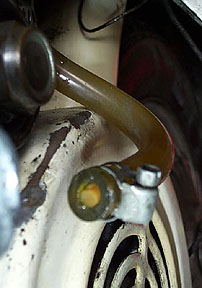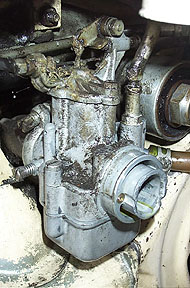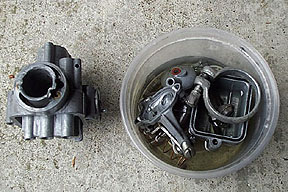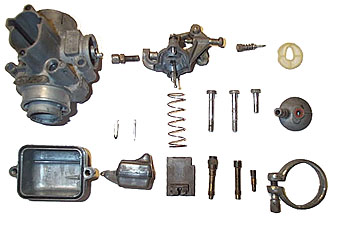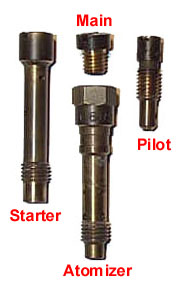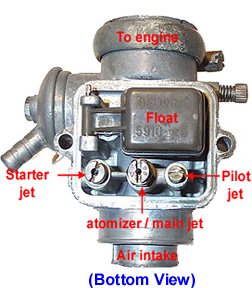Lambretta1968 Li125 S |
Carb cleaningWhen gasoline sits for a while in a scooter it turns to a yellow goo that clogs filters, jets and fuel taps. All these items should be removed and cleaned and the fuel tank should be drained and refilled with clean gasoline. The tank on this bike was (amazingly) very clean and only needed draining. The fuel tap can be removed with a wrench from the base of the gas tank. I took apart the fuel tap to be sure it was not clogged. The main brass housing can be removed from the rotating fuel tap by clamping (lightly) the tap body in a vise and unscrewing the rotating assembly. Be sure to check that the filter and all the passage ways are clean by blasting it with compressed air or carb cleaner. I replaced the fuel line because the gasoline had changed to a solid sun tan cream consistency as shown below.
I removed the rubber air supply bellow from the carb and found that someone had become very frustrated with this carb in its former life. The intake face had been hammered flat and the identifying carb text had been flattened. The inside face of the venturi was also scared badly - while I don't think any of these items will affect the final engine performance too much, as none of the passageways are fouled, a new carb body would be recommended.
Cleaning a carb is an easy process and requires taking it completely apart. Buy a bottle of carb cleaner preferably with a small tube to attach to the aerosol head for tight areas and blasting out air/fuel passages. Be sure to have an assortment of various sized screwdrivers and some smaller metric wrenches. The brass jets are fragile and can be damaged by using the wrong sized screwdriver. Start by unscrewing every possible part of the carb and soak them all in a dish full of carb cleaner.
Below is a shot of all the parts in a Lambretta Series III carb, cleaned and ready for re-assembly. Blow through all jets with compressed air or use a straw with a pen cap as a tip and blow through them with your lungs.
The jets and airways of a carb a very important to keep clean and free of debris. There are two filters in the fuel system to keep gas clean. One is located in the intake on the fuel tap and the other is where gas enters the carb. Both these should be checked to be sure they are clean. Below is a quick overview of the jets in a Series III carb. The jets are brass and only the main jet and atomizer are screwed together as a single unit. Gasoline enters the carb and is drawn directly into the float chamber. Inside the float chamber there is a ball-cock assembly similar to a toilet tank on a small scale. It stops the gasoline from being able to flood the venturi tube and upset the air/gas mixture. With the gasoline supply stemmed by the float the jets can suck up gas from the float chamber where it is mixed with air in the venturi and then makes its way into the crankcase.
The jets all have small text to identify them. The jet size is very important in a carburetor and the incorrect jet can produce an engine that can run roughly or even hole a piston. Jet sizes are listed for both Vespas and Lambrettas on the model pages.
Next Section --> |
||||||||||||||||||
